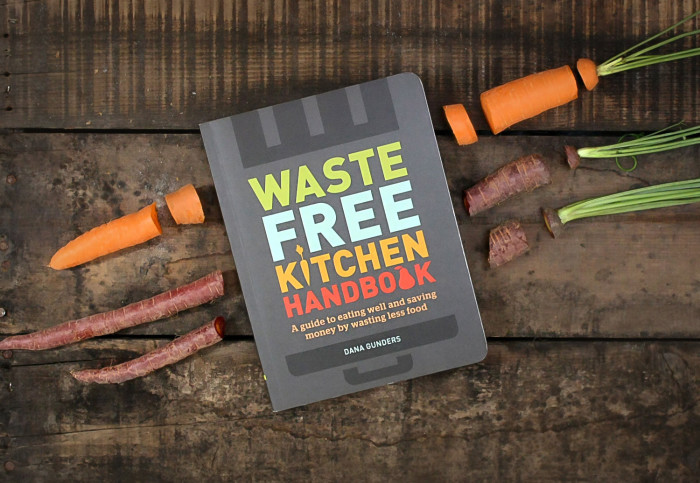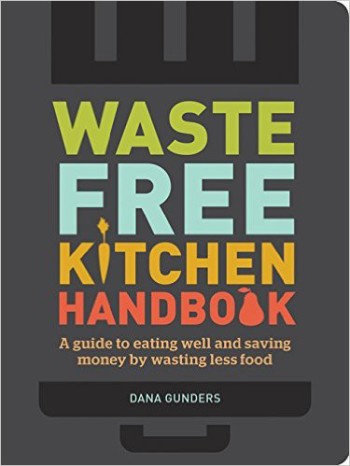Dana Gunders’ 10 Tips for a Waste Free Kitchen

Consider this harrowing fact of modern-day American life: About 40% of food in the United States goes uneaten. “That’s crazy!” writes Dana Gunders, author of Waste Free Kitchen Handbook: A Guide to Eating Well and Saving Money by Wasting Less Food. “It’s like buying five bags of groceries and then dropping two of the bags in the grocery store parking lot and not bothering to pick them up.”
The waste has huge environmental consequences. About half the land area and 70% of the freshwater in the U.S. is used for agriculture. Demand for food drives deforestation and water shortages here and in other countries and prompts the use of pesticides and fertilizers that damage sensitive ecosystems. And right now, food is the single largest part of the municipal solid waste going to landfills, where it swiftly decomposes and releases methane, an even more powerful greenhouse gas than carbon.
How do we reverse this disturbingly wasteful trend? In her engaging new book, Gunders, a staff scientist for the Natural Resources Defense Council, says the solution lies in incorporating simple new habits into your routine. Her ingenious strategies include how to outsmart grocery store marketing, properly store foods to maximize freshness, decipher expiration dates, and creatively (and deliciously) use up items like those shriveled green onions that stare at you accusingly from the back of the veggie drawer.
One of the most effective strategies you can start with is meal planning. In this excerpt below from Waste Free Kitchen Handbook, Gunders shares ten tips to help us plan dishes and avoid common food-wasting pitfalls—all of which will not only save you money, they might just improve the world, one carrot at a time.
Ten Key Elements of Meal Planning
While it may be obvious that meal planning involves choosing meals to eat for the week and creating a shopping list for those meals, a handful of not-so-obvious tips can make the process more effective.
- Don’t start from scratch. No one is scoring you on your creativity. Meal planning does not mean hours with cookbooks every week. You likely already have a few meals that are regulars in your household. Count those in. Repeat them every week or two. Then, if you’re up for it, try something new once in a while.
- Check the refrigerator. Your refrigerator is the starting gate for planning the next week’s meals. What needs using up? What’s a good meal to make with the other half of that broccoli, the last of the cottage cheese, and the leftover pasta from two days ago? Sounds like a baked pasta dish might do the trick, and you’ll need to buy some pasta sauce and mozzarella to make that work. Add those to the shopping list (after you’ve checked to be sure you don’t have them in the pantry) and voilà. Meal one. Check.
- Use portion planners. Use a portion calculator to figure out how much pasta or chicken or vegetables to make for your group size. Portion calculators are particularly helpful when you’re feeding a bigger group, but they might also add some insight as to why you always wind up with extra rice. There are many on the Web to choose from.
- Have kitchen essentials on hand. Having two to three grains, cooking fundamentals, some key spices, and “hero” sauces that come to the rescue can bring new life to old meals.
- Choose building blocks. Pick two types of protein, one or two grains, and a vegetable medley that you can make at the beginning of the week and then incorporate into different meals. For instance, a sauté of broccoli and peppers can be used as a side one night, spooned on enchiladas another night, and then worked into a soup or meatloaf later in the week. Brown rice or mashed potatoes could be incorporated into each of those meals as well. With different spices and sauces, it won’t feel as though you’re eating the same thing every night.
- Think double duty. If you’re planning for Tuesday taco night, what else could you use tortillas up for? Maybe some Asian salad wraps later in the week, or those enchiladas? How about the cilantro? Unfortunately, the ingredients we need don’t always come in the portions we need them in. Incorporating those ingredients into multiple meals will help you avoid the end-of-the-week overload. After you choose one meal, consider which ingredients come in large quantities, and plan a second meal around those.
- Schedule in a lazy night. Or two or three. So often we go to the store with hopes and dreams of preparing fresh meals all week, but the reality is we don’t have the time or energy to cook every night. So planning on lazy nights that don’t involve cooking is key—whether you order in or take an already prepared food from the freezer. With my current crazy schedule, I plan to make only three meals each week. The rest are a combination of what’s in the freezer, Thai takeout, and dinner with friends. This also helps make sure food doesn’t get lost in the freezer for too long, since I know there are nights I’ll be scrounging in there for dinner.
- Go fresh first. For optimal nutrition and freshness, use perishables like fresh seafood and meat earlier in the week and make staples (pasta, dairy, omelets) later in the week. Some greens, such as kale and chard, will maintain their freshness longer than others.
- Lean on frozen ingredients. I always keep a bunch of frozen vegetables on hand. They fill in the gaps, allowing me to buy only a handful of fresh vegetables that I know I will use each week, and helping me avoid going shopping late in the week if I’ve run out. From a health perspective, frozen foods have nearly all of the nutrients, and sometimes even more, of fresh.
- Cook batches and freeze. Soups, stews, casseroles, lasagna—all can be made in large batches, frozen, and defrosted when you’re in need of a quick dinner on one of those lazy nights. Having these around saves you from having to plan every meal for the week.
Bonus tip: Want to skip all the planning stuff? Shop more often. Really, meal planning plays a critical role because we are buying food for a whole week and have to anticipate needs for all those meals. Shopping on a more frequent basis means you don’t have to stock up on things and can rather buy just what suits your mood that day. No planning necessary.
This might not work for everyone, depending on your available time and proximity to a market. But if you can make it happen, your meals will be fresher, planning will be less essential, and you may find you’ve added a little more flavor to your life.
Pick up Waste Free Kitchen Handbook from Chronicle Books.



LET'S GET SOCIAL